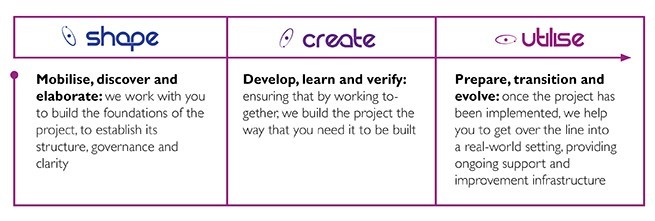Focussing on outcomes is essential to the success of any project. What does the project need to achieve? It sounds like an obvious question, but time and again we see vague notions of what the outcomes are. Procuring a technology system isn’t the end of the process. It needs to be designed, structured, implemented and have a plan put in place for its ongoing success post go-live. How will the people using the new system be trained? What, ultimately, will success look like? A robust requirement discovery phase of the project helps both parties to understand one another and outline the objectives of the project.
At CACI, we utilise our proprietary FUSION project delivery methodology with all of our customers and for our internal projects. This helps us to keep work on track, whilst further enabling us to continually learn from project implementation to continuously improve our own processes. Spending that time early in the lifecycle of the project to fully understand what it is you need to achieve enables us to set clear goals and create a point of reference for the remainder of the project.
Here we can establish what success will look like, creating a baseline of requirements and their acceptance criteria for sign off.
Requirement discovery building knowledge and insight
The success of any project is underpinned by the people involved. Getting both teams together so that they can build knowledge and insight of how each other works is invaluable in putting in place the groundwork for a successful project.
The definition of success and acceptance criteria created during the requirement discovery phase of the project acts as a reference point for the rest of the project. The requirements laid out at this stage are designed to establish what you need from the project, not describe the solution. It is important, therefore, to prioritise your requirements, understand what you want to achieve and set out your acceptance criteria at this stage. Who needs to do what, by when? What will tick your boxes in order to advance the project?
The involvement of key roles such as the project sponsor are vital in ensuring buy-in from key personnel and following up on your requirements to ensure that they are appropriately managed.
This isn’t just about managing the change in technology that you’re experiencing, there’s the human element to consider, too. We covered this in our previous blog about change management, but it’s worth reiterating since the requirement discovery phase further enables discussion around the tangible impact to the people who are affected by the change. Getting buy-in from everyone early in the project is good practice and the discovery phase is vital in building that knowledge and insight that will facilitate a smoother change management process when the (agreed upon) time is right.
The importance of epics in requirement discovery
Epics are an important way of breaking down a larger body of work, such as a software implementation, into user stories that work towards the intended outcome of the overarching project. This helps both teams to break their work down whilst continually working towards the bigger picture.
CACI helps customers in creating these, since they enable us to focus on your outcomes, putting them front and centre of the project. We’re providing the solution, but your required outcomes are bespoke to you. Creating epics enables us to focus on this during the process of delivering your solution.
The creation of epics also enables us to come back to your requirements and how we intend to achieve them. With the overarching project broken down into smaller sprints of work, it enables us to focus on the delivery of key requirements across the project.
How CACI can help you deliver the outcomes you need
The purpose of the discovery phase is to build insight and understanding between our team and yours. Reading requirements on a tender is one thing, but how will they look in reality? We aim to embed our team within yours, which is why discovery is so important. This enables us to tailor the solution to your needs, with your required outcomes at the forefront of the project implementation.
We’ve seen all manner of projects in our time. Most have gone well, but we’ve also been involved in projects where shortcuts have been taken and the project has been executed without the involvement of those who will be most impacted by the project: that is to say, those who will be using the solution day in, day out.
Discovery is such an important step in the project. It enables us to create an agreed path forwards against set deliverables, acting as a point of reference as the project advances. The project lifecycle can be difficult to manage, but by breaking it down and understanding what you need the solution to deliver, it makes it easier to pinpoint where things are veering off course.
Our team of project managers have seen it all before, across a multitude of industries. Selecting a technology provider and their solution is one thing, but what happens next is so important to the solution being successful for you. We always strive to place your outcomes first, to ensure that the solution and the project work to deliver what you need.
Learn more about CACI’s requirement discovery, see our brochure here.



